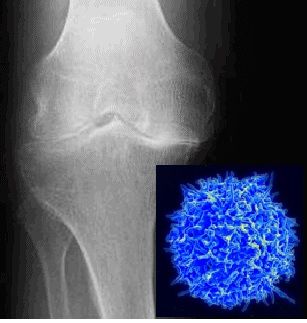Article
Macrophages and CD4+ T Cells Found Lurking in Arthritic Knees
Synovitis is present in 90% of painful knees, and emerging data is showing that this inflammation is "not just a bystander" in osteoarthritis-induced damage. Research is revealing the roles of macrophages and T-cells, and signposts toward new drug targets.
Synovitis is present in 90% of painful knees, and emerging data is showing that this inflammation is "not just a bystander" in osteoarthritis-induced damage, said orthopedist-researcher Babak Moradi MD of the University of Heidelberg. But the identity of the relevant cells and the time frame of their actions have been unknown.
Presentations at the meeting of the Osteoarthritis Research Society International

have resolved some of this uncertainty, and may suggest routes to new treatment options.
A major new insight was that, as in rheumatoid arthritis, macrophages were present in two-thirds of knees with osteoarthritis (OA) and also frequently associated with pain in the shoulders, hands, and feet of these patients with knee OA. This information, from studies using a technecium 99-labeled folate marker for imaging studies employing single-photon emission computed tomography (SPECT/CT), constitutes the first direct in vivo evidence for macrophage involvement in humans with OA, said Virginia Byers Kraus MD PhD, professor of medicine at Duke University, speaking for a team that included researchers from Purdue University and Eli Lilly.
The tests also revealed significant associations between the macrophage marker signal on imaging and the presence of joint space narrowing, osteophytes, and symptoms, Byers Kraus said. Drugs that target macrophages or inflammatory pathways associated with them may be found useful for OA.
In a related study, working with Duke's Hikmat Daghestani PhD, Kraus found that cell-surface biomarkers shed from activated macrophages may prove useful to identify subtypes of OA patients with active, ongoing inflammation.
Moradi and his team have used flow cytometry to study the emergence and patterns of the entire population of mononuclear cells during synovial fluid changes after knee injury, using the well-accepted mouse model for OA, the microsurgical DMM (destabilization of the medial meniscus), compared with a sham procedure and with non-operated controls.
"The sham was quite traumatic," said Moradi. "We touched the ligaments and the meniscus; we just didn't sever it." Nonetheless the team saw significant differences between the two procedures in synovial tissues stained with markers for T cells, macrophages, and monocytes.
Although there were rapid increases in mononuclear cells of all types after either procedure, a striking difference emerged over time. A peak in T-cell activity four to five weeks after surgery was larger and more sustained for the DMM group. After eight weeks post-procedure the T cells, particularly the subtype CD4, persisted only in the mice with true meniscal damage.
The pattern is significantly different from that seen in would healing but is reminiscent of changes in human OA, Moradi said, and suggests that the depletion of synovial T cells may also offer a new treatment option for OA.




